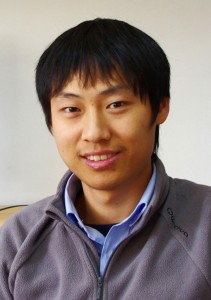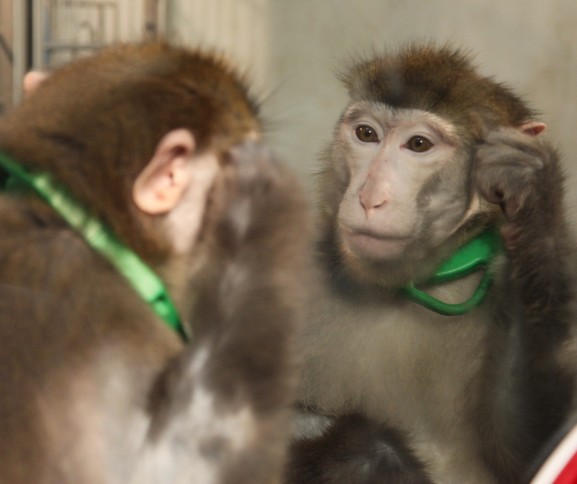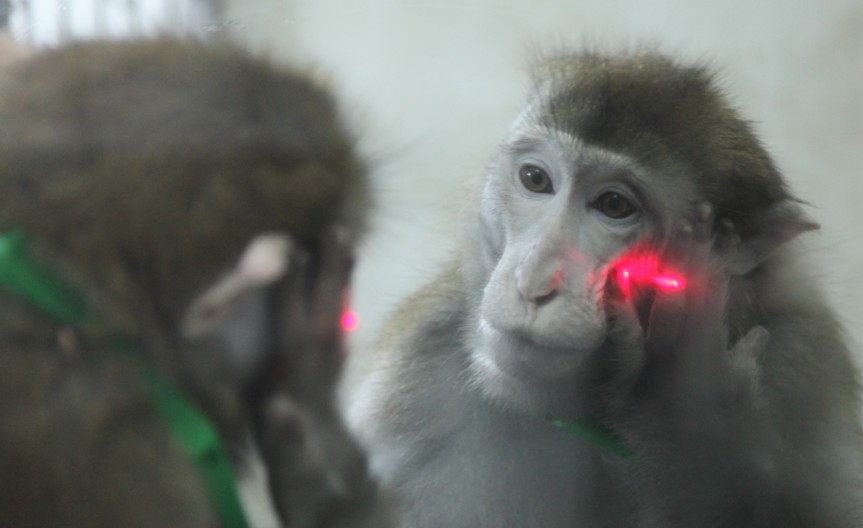It has long been common scientific knowledge that monkeys don’t realize that the reflection they see in the mirror is their own. But, according to new research by the Chinese Academy Sciences, monkeys can learn to recognize their reflections.

“Mirror self-recognition is an indication of self-awareness, which is a hallmark of higher intelligence in humans, as an indication of self-awareness. This ability may be acquired through training in monkeys,” Dr. Neng Gong of the Chinese Academy of Sciences, lead researcher of the study, told The Speaker. “Thus scientists can now study the neural circuit mechanisms underlying the emergence of self-awareness.”
Although humans and great apes have been found to recognize their reflections, rhesus monkeys had not. Over the course of decades of testing, rhesus monkeys failed to show any signs of self-recognition, such as touching and examining themselves while looking at the reflected image.
The monkeys could, however, use the mirrors as tools to observe other objects, previous studies showed.
The Chinese study tried a new approach and obtained new results. Rather than offering rhesus monkeys variously shaped and size mirrors as in past studies, Gong and his colleague taught the monkeys that a spot of irritating light shined on their faces was the same the monkeys saw in the mirror image.
The researchers spent 2 to 5 weeks training the monkeys by directing a laser light onto their faces while the monkeys sat in front of mirrors. The monkeys learned to touch the light spot on their faces that they could not feel–only see in the mirror.
The monkeys–or five out of seven, anyway–touched the light spots and also looked at and smelled their fingers after touching the light spot.
 The monkeys also continued to explore using the mirror image to investigate parts of their bodies they didn’t normally see.
The monkeys also continued to explore using the mirror image to investigate parts of their bodies they didn’t normally see.
The researchers concluded that the monkeys had passed the test for mirror self-recognition.
“Our findings suggest that the monkey brain has the basic ‘hardware’ [for mirror self-recognition], but they need appropriate training to acquire the ‘software’ to achieve self-recognition,” the researchers stated of their work.
“In an evolutionary view, the ability of self-recognition seems not so important for monkeys, because they do not need this ability for living,” Gong told us. “However, for humans, self-awareness is the most important function for higher human-specific brain function for social behaviors, e.g., sympathy, empathy, perspective-taking (understand the situation by taking other’s perspective), and language communication. Understanding the neural basis of self-awareness and consciousness is the ultimate goal of understanding the human brain, and this has been a very difficult subject for experimental studies. By demonstrating that self-awareness-like behavior of mirror self-recognition can emerge in monkey after training, we now have an animal model to study what neural circuit changes that enable the emergence of self-awareness.”
The study is expected to shed new light on the neural basis of self-awareness among animals. It also is expected to hold hope for sufferers of diseases like Alzheiers, schizophrenia, autism and mental retardation, in which people are unable to recognize themselves in mirrors.
“Mirror neurons were first discovered in macaque monkeys and thought to be a mechanism for imitation behaviors,” Gong told us. “In human beings, it has been speculated that mirror neuron systems are the brain mechanism underlying self-awareness and empathy. It is possible that the ability of rhesus monkeys in acquiring mirror self-recognition depends on their possession of mirror neuron systems.
“Our study raises the possibility that monkeys can be used as an animal model to test this hypothesis. This calls for further brain imaging and neural circuit analysis of the changes in the monkey’s brain before and after training of visual-somatosensory association and in those monkeys that passed or failed the mark tests after training.
“Indeed, we have already started further mechanism studies.”
The report, “Mirror-induced self-directed behaviors in rhesus monkeys after visual-somatosensory training,” was authored by Neng Gong and was published in Current Biology.
Photos: Neng Gong and colleagues/Current Biology 2015

Very interesting, and well written article.